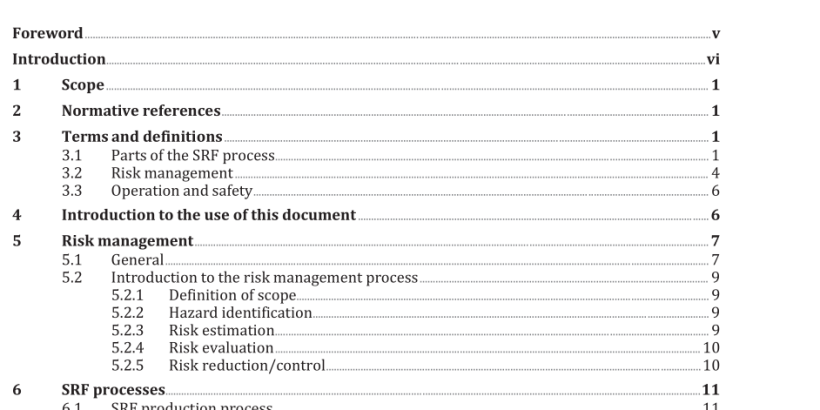ISO 21912:2021 pdf download – Solid recovered fuels — Safe handling and storage of solid recovered fuels.
1 Scope This document provides principles and requirements for safe handling, treatment and storage of solid recovered fuels (SRF), prepared from non-hazardous waste, to be used for energy purposes. This document covers process stages from point of acceptance of material to point of delivery of SRF. This document excludes fuels that are included in the scope of ISO/TC 238 Solid biofuels and ISO/TC 28 Petroleum products and related products of synthetic or biological origin. It uses a risk-based approach to determine what safety measures are to be considered. Although unloading and loading of e.g. vessels, trains or trucks are included, the safety issues following the loading and transport itself are not.
2 Normative references The following documents are referred to in the text in such a way that some or all of their content constitutes requirements of this document. For dated references, only the edition cited applies. For undated references, the latest edition of the referenced document (including any amendments) applies. ISO 12100, Safety of machinery — General principles for design — Risk assessment and risk reduction ISO 21637:2020, Solid recovered fuels — Terminology, definitions and descriptions
5 Risk management 5.1 General To improve the safety during production, handling and storage of SRF, both design and operation shall be considered. Safety concerns anyone who is responsible or exposed to the hazards arising from the activities within the premises, here limited to the scope of this document. For identified hazards the following hierarchy shall be followed as a minimum: 1) Elimination 2) Substitution 3) Engineering controls 4) Administrative controls 5) Personal protective equipment (PPE) The items above shall be addressed as early as during the design stage, as well as during operation and maintenance. For the operational management of occupational health and safety, the Plan-Do-Check-Act (PDCA) model according to ISO 45001 should be used. An important part of these processes, both during design and operation, is management of risk, which includes several steps and sub-steps. For this document the detailed steps which shall be followed and documented for the general risk management are shown in Figure 1 .
The risk management process includes a risk analysis and a risk evaluation, which form the basis for the risk assessment and what risk reduction/control measures are required for each specific plant. The objects, issues and aspects to be considered and documented in the risk management process are related to general design and construction and general operation and maintenance procedures including preplanning of emergency operations. For fire prevention and fire protection of machinery, ISO 19353 should be used, when applicable. Further specific issues to consider are also provided for receiving and feeding (8.1.1); crushing, milling and shredding (8.2); conveying (8.3); storage solutions (8.4); separation and screening (8.5); and other systems (8.6). The documentation shall describe and justify the measures taken, as well as include aspects not considered applicable or relevant. The person responsible for the risk management process shall have the necessary levels of competence to undertake a fire and explosion risk assessment; the level of competency required should be commensurate with the complexity of the facility to be assessed, i.e.: a) A good understanding of SRF and the equipment and processes used for the production and along the supply chain of SRF b) A good understanding of fire related aspects of building control and function c) Appropriate knowledge of national fire/explosion and safety legislation and the requirements of other enforcing bodies and stakeholders (i.e. insurers)
5.2.1 Definition of scope When performing a risk analysis, the scope shall be defined, i.e. the system that is to be included in the analysis. This includes definition of the boundary of the system and to identify user, intended use and reasonably foreseeable misuse. Assumptions and limitations for the analysis should also be defined. Technical, environmental, organisational and other aspects relevant for the problem/system should be included. 5.2.2 Hazard identification Hazard identification involves systematic review of the system under study to identify the type of inherent hazards that are present together with the ways in which they could be realized. Different hazards and sources of risks shall be identified and the type of hazard they pose analysed. Hazard identification methods fall mainly into three categories: 1) Comparative methods (e.g. checklists, hazard indices and reviews of historical data) 2) Fundamental methods, that are structured to stimulate a group of people to apply foresight in conjunction with their knowledge to the task of identifying hazards (e.g. HAZOP studies, ISO 12100 and FMEA) 3) Inductive reasoning techniques (e.g. event tree logic diagrams).
